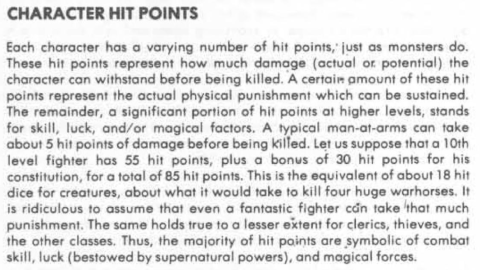The conversation around what Hit Points (HP) are and what they represent in Dungeons & Dragons (D&D) is a cyclical one. It’s a concept that periodically bubbles up in the tabletop role-playing game (TTRPG) community, like an ancient dragon in its cyclical slumber, and we seem to be in the midst of another awakening.
It’s no surprise that understanding HP often seems like trying to learn Draconic without a spell of Comprehend Languages. Table Top Roleplaying Games are narrative adventures, so we naturally want to weave a compelling story around every game element. And therein lies the enigma of Hit Points - no matter how you narrate them, you’re likely to walk into a wall of confusion and pile of contradictions.




A Historical Perspective
Many D&D elements, including HP, sprung from the hobby’s wargaming roots. In those days, units usually had a defensive score and an offensive score. The outcomes were binary: units either lived or died. But when these concepts morphed into the individual tactical combat that defined Original D&D (OD&D), there was a need for a way to track the progress towards defeat, thus giving birth to Armor Class (AC) and Hit Points (HP).
In OD&D, AC denoted how challenging you were to hit, and HP showed how close you were to defeat. The game simply states, “Your hit points determine how hard your character is to kill.” And that’s it. That’s the HP origin story. They’re an arbitrary, abstract measurement of how difficult you are to kill and how far along the game is in achieving that.
The Evolution of HP
Later D&D editions got increasingly philosophical about HP. Advanced D&D acknowledged physical punishment, but clarified that “a significant portion of hit points, especially at higher levels, stands for skill, luck, and/or magical factors.” It even said it would be “ridiculous” to assume characters could endure such physical punishment, further emphasizing that HP are not intended to be taken literally.
2nd Edition D&D kept the abstract theme, defining damage as an abstract concept that allows characters to be heroic. It didn’t dwell on the semantics of HP. 3rd Edition, on the other hand, leaned into the mechanics and didn’t provide a narrative explanation for HP and damage at all. 4th Edition tried to have the best of both worlds, setting a base number of hit points representing “real” damage, while anything over was the old dance of skill, luck, and magic.
By the time 5th edition D&D came around, we’re back in the abstract realm, with the game stating, “Hit Points represent a combination of physical and mental durability, the will to live, and luck.”
Hit Points: Setting the Stage, Not defining the Genre
Hit Point mechanics are integral, but the presence of HP doesn’t force your game into a specific genre. That job is for the Dungeon Master, who tailors how this mechanic comes into play. For instance, early D&D editions painted a grim, risky scene with low HP and tight damage thresholds, providing a sword-and-sorcery feel. In contrast, 5th Edition, with its generous HP pools and high-damage exploits, resonates with high-fantasy heroics.
Remember, it’s not the existence of HP that set these styles; it’s their application. As the DM, you have the freedom to adjust this tool to shape your campaign’s tone, from injecting grimdark elements into a 5th Edition game by reducing HP, to amping up the heroics in a 1st Edition game by increasing HP totals. At the end of the day, HP is a vital but flexible aspect of the D&D universe.
Hit Points: Tools, Not Shackles
It’s crucial to remember that Hit Points are a mechanic, not a set of shackles for the DM. They have their boundaries and are not designed to simulate everything could befall a character. Every edition of D&D underscores this, suggesting that the DM delineates these limits.
For instance, if a character decides to take a dip in a lava pool or plunge from a mile-high cliff, many DMs might opt not to roll damage, deeming these situations unsurvivable. In such cases, the official material often advises DMs to declare character death outright, instead of getting tangled in the mire of damage dice. However, if these drastic scenarios occur frequently in your game, it might be worth reassessing your game design.
On the flip side, some DMs might channel a superhero vibe, letting characters brush off falls from great heights. That’s equally valid. As with any ruling in a tabletop RPG, maintaining an internally consistent world is the important part.
The bottom line? Understanding the tone of your game and setting appropriate limits is key when navigating the world of Hit Points. Keep this in mind as you weave your epic tales of adventure.
Living with the HP Conundrum
Trying to define Hit Points is like grappling with a Mind Flayer — it’s a sure path to madness. Make it too abstract, and you create a narrative disconnect. Make it too literal, and you grapple with the absurdities of surviving a lava bath or healing from the brink of death overnight.
In my humble opinion, D&D intends for players to embrace the vagueness of Hit Points. They’re not ‘meat points’ or a measure of your plot armor, but more an abstraction of your character’s struggle to survive. Like most time travel plotlines, it’s nonsensical. So, just wave your hand, enjoy the game, and let the Hit Points fall where they may. Their purpose is to serve the adventure, the narrative, and ultimately, the fun. Because, in the end, who needs a physics lesson in the thermal dynamics of lava when you can have a daring escape from a volcano instead?
Now get out there and run some great games!